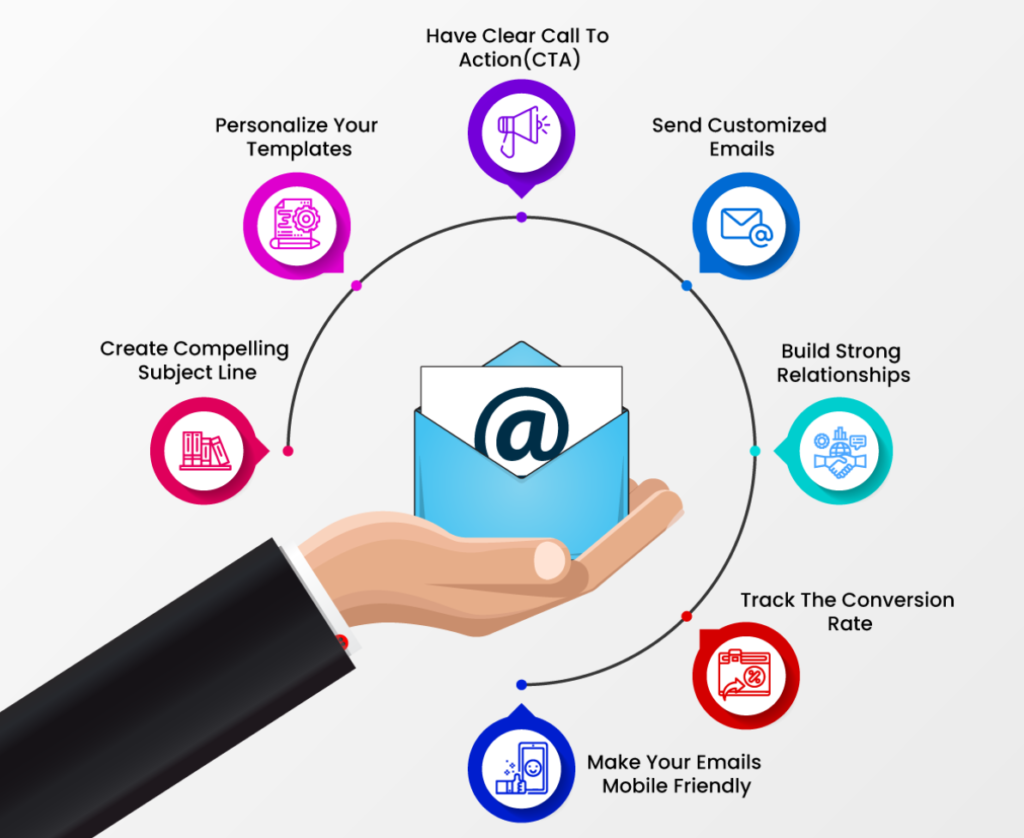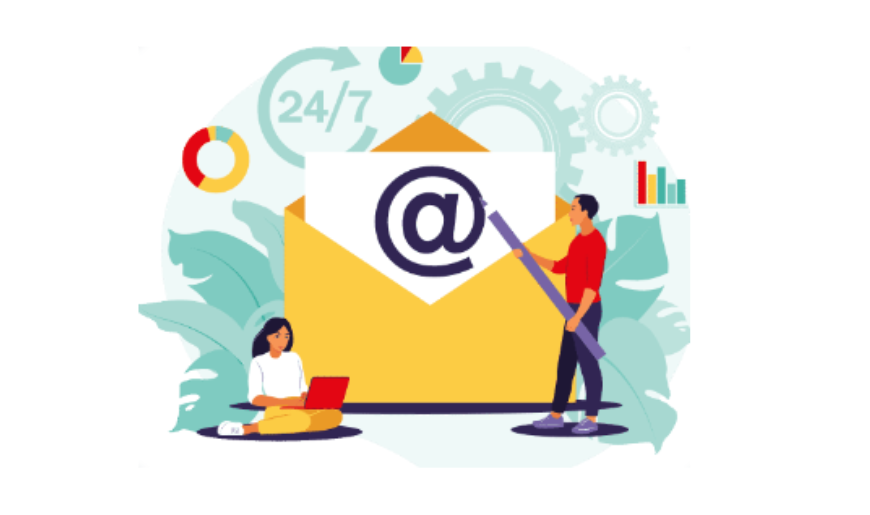Email campaigns are a crucial component of any successful marketing strategy. They can be used to engage with potential customers, foster relationships with existing customers, and ultimately drive conversions.
One of the most compelling reasons to embrace email marketing is its cost-effectiveness. Compared to traditional marketing channels like print advertising or direct mail, email marketing offers an exceptional return on investment (ROI). It allows businesses of all sizes, from startups to enterprises, to reach a vast and targeted audience without draining their financial resources.
To maximise the effectiveness of your email campaigns, there are several best practices to keep in mind.
Fill your email list with your target audience
Acquiring the ideal email subscribers to join your email list marks the crucial initial phase in setting up a well-structured and effective sales funnel. This pivotal step serves as the foundation upon which you’ll build your entire digital marketing strategy. As you embark on this journey, it’s imperative to understand that the quality of your email subscribers is just as important, if not more so, than the quantity.

In a world where digital communication is ubiquitous, gaining access to someone’s inbox is a privilege. Therefore, it’s essential to ensure that the individuals who willingly subscribe to your emails are not just random passersby, but rather individuals genuinely interested in your products or services. This targeted approach not only enhances your open and click-through rates but also significantly improves your conversion rates down the funnel.
So, how do you attract the right email subscribers? The process involves a careful blend of strategic marketing tactics and ethical engagement practices.
Let your potential subscribers know what they can expect from your emails, whether it’s weekly newsletters, informative articles, or special promotions. This clarity will help set expectations and ensure that those who choose to subscribe are genuinely interested in your offerings.
Segmentation and Personalisation
First, it’s important to segment your email list into distinct groups or segments based on shared characteristics or behaviors. This segmentation could be based on factors such as demographics (age, gender, location), purchase history, engagement level (e.g., frequent openers vs. sporadic openers), or even the source through which they joined your list (e.g., website sign-up, social media, in-store sign-up).

Segmentation enables you to send targeted messages that are relevant to each group’s specific interests or needs. For instance, you might send different promotional offers to long-time customers compared to new subscribers who have just joined your list. You could also craft region-specific content or seasonal promotions for subscribers in different geographical areas. This tailored approach enhances the likelihood that your emails resonate with each segment, driving higher open rates, click-through rates, and conversions.
Personalisation, on the other hand and as the name suggests, involves customising your email content for each subscriber based on their unique characteristics, behaviors, and interactions with your brand. This goes beyond merely addressing them by their first name in the salutation. Personalisation delves into the heart of what makes each subscriber tick. It might involve recommending products or services based on their past purchases or browsing history, suggesting content that aligns with their interests, or acknowledging milestones like birthdays or anniversaries.

By harnessing the power of personalisation, you demonstrate that you understand your subscribers as individuals, not just as faceless members of a mass mailing list. This fosters a sense of connection and loyalty, ultimately increasing engagement and conversion rates.
In essence, personalisation and segmentation allow you to create a more dynamic, relevant, and engaging email experience for your subscribers, leading to increased customer satisfaction and brand loyalty. When used effectively, these strategies can significantly boost the effectiveness of your email marketing campaigns and contribute to the overall success of your digital marketing efforts.
Compelling Subject Lines
Crafting captivating subject lines represents yet another essential best practice. These subject lines serve as the gateway to your email content, acting as the first point of contact with your recipients. Their significance cannot be overstated, as they play a pivotal role in determining whether your email will be opened and engaged with or relegated to the abyss of the inbox.

To create subject lines that truly stand out, it’s crucial to understand that today’s email users are inundated with a constant stream of messages vying for their attention. In this digital cacophony, a well-crafted subject line can be the beacon that guides your email to the forefront of a recipient’s inbox.
One effective approach to crafting compelling subject lines is to pique curiosity. Tease the recipient with a hint of what lies inside the email, leaving them eager to uncover the rest of the story or the valuable information you promise to provide. For example, a subject line like “Unlock the Secret to Doubling Your Sales” generates intrigue and encourages the recipient to explore further.
Another tactic is to create a sense of urgency or exclusivity. By incorporating phrases like “Limited Time Offer” or “Exclusive Access,” you convey the idea that the recipient must act promptly to seize a valuable opportunity. This can spur immediate action and boost open rates.
Furthermore, personalisation (as we mentioned before) can be a powerful tool in subject line creation. When a recipient sees their name or personalised content tailored to their preferences in the subject line, it can create a more intimate and engaging connection. For instance, “John, Your Exclusive Offer Awaits!” adds a personal touch that can make the email feel more relevant and enticing.
It’s also wise to keep subject lines concise and to the point. Mobile devices are increasingly the platform of choice for checking emails, and shorter subject lines are more likely to display fully on smaller screens. Aim for brevity while still conveying the essence of your message.
A/B testing can be instrumental in refining your subject line strategies. By experimenting with different approaches, you can gain valuable insights into what resonates best with your audience. Test variations in wording, tone, and style to discover which subject lines consistently yield the highest open rates.
Value-Oriented Content
At the heart of every successful email campaign lies valuable content. This foundational principle serves as the bedrock upon which your entire campaign strategy is built, and its influence cannot be overstated.
Valuable content in emails is akin to the soul of your campaign, and it takes various forms, depending on your goals and the preferences of your audience. It encompasses everything from insightful articles and informative guides to engaging visuals and exclusive offers. This content, carefully curated and strategically deployed, serves as the driving force behind achieving your email marketing objectives.
First and foremost, valuable content captures your audience’s attention. In today’s fast-paced digital world, where information overload is the norm, your emails need to stand out. High-quality content that informs, entertains, or solves a problem has the power to halt the scroll, pause the busy inbox skimming, and prompt the recipient to engage with your message. It sparks that initial spark of interest and curiosity, making the recipient receptive to your message.
Moreover, valuable content builds trust. When your emails consistently provide relevant and beneficial information, your audience begins to see you as a credible and authoritative source within your niche or industry. Over time, this trust translates into brand loyalty and customer retention, as recipients come to rely on your emails for valuable insights or offers.
Beyond capturing attention and fostering trust, valuable content is the linchpin for driving action. Whether your email’s goal is to encourage a purchase, promote an event, or nurture a lead, the content you deliver plays a pivotal role in motivating your audience to take the desired action. Well-crafted calls-to-action (CTAs) within your content, strategically placed and aligned with your message, guide recipients toward the next step in the customer journey.
In addition to its immediate impact, valuable content has a lasting effect on your brand’s reputation. Exceptional content has a way of being shared, forwarded, and even stored for future reference. When your emails consistently provide value, your recipients are more likely to pass them on to others who may benefit from the same information or offers, extending your brand’s reach and influence.
Lastly, valuable content fosters long-term relationships with your audience. It’s not just about a single email campaign but about nurturing an ongoing connection. When recipients consistently find value in your emails, they look forward to receiving them and are more likely to remain subscribed, engage with your brand, and become loyal customers or advocates.
The more valuable your content, the more your audience will engage, recognising your emails as fonts of worthwhile information.
Clear Call to Action (CTA)
Every email you craft should have a clear, actionable Call to Action (CTA). A well-crafted CTA is, in essence, the culmination of your email’s purpose. It encapsulates what you want your recipients to do next, whether it’s making a purchase, signing up for a newsletter, downloading an e-book, scheduling a demo, or any other action relevant to your campaign goals. Without a clear and compelling CTA, your email risks becoming an aimless message lost in the sea of the inbox, rather than a powerful marketing tool.
The text should leave no room for ambiguity, clearly conveying the benefit or outcome of clicking the button or link. Action-oriented words like “Buy Now,” “Subscribe Today,” “Learn More,” or “Get Started” are tried-and-true choices that convey a sense of urgency and motivation.

Remember, the essence of successful email marketing lies in providing value and building relationships. By consistently honing your strategy and analysing engagement metrics, you’ll not only engage your audience but also pave the way for increased brand loyalty and conversions.
It’s important to track and analyse the performance of your email campaigns. This will allow you to identify what is working well and what can be improved, and make data-driven decisions to optimise your future campaigns.
By following these best practices, you can turn your email campaigns into powerful tools for driving engagement, fostering relationships, and ultimately boosting conversions.


